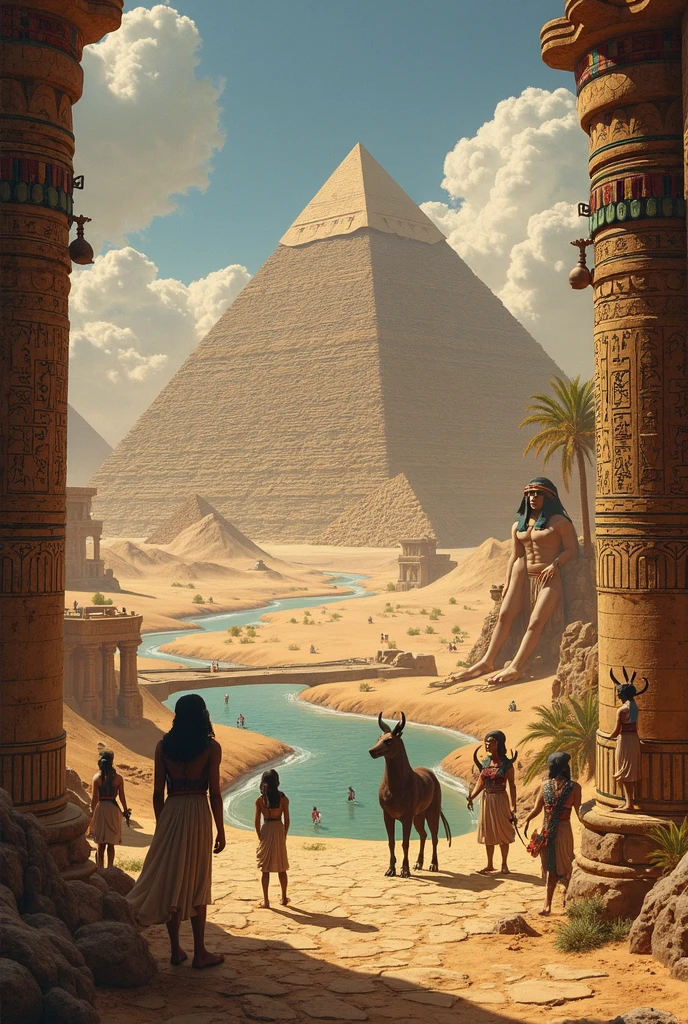Phoenician Mythology: Gods, Legends, and Ancient Beliefs
The mythology of the Phoenicians, an ancient seafaring civilization, is rich with powerful deities, epic tales, and cultural influences that spread across the Mediterranean. Among their most revered gods was Baal, the storm god and king of the pantheon, whose worship extended from Tyre to Carthage. Alongside him stood figures like Astarte, the goddess of love and war, and Melqart, the protector of sailors and cities. This article explores the fascinating world of Phoenician mythology, its key figures, and its lasting legacy.
The Pantheon of Phoenician Gods
The Phoenician religion was polytheistic, with gods representing natural forces, human endeavors, and cosmic order. Their deities were often linked to specific cities, reflecting the political and cultural landscape of the time.
Major Phoenician Deities
- Baal – God of storms, fertility, and kingship.
- Astarte – Goddess of love, fertility, and war.
- Melqart – Patron god of Tyre, associated with the sea and monarchy.
- El – The supreme father god, creator of the universe.
- Tanit – A prominent goddess in Carthage, linked to fertility and the moon.
Baal: The Mighty Storm God
Baal, whose name means “Lord,” was one of the most significant gods in Phoenician mythology. He was worshipped as a bringer of rain, essential for agriculture, and as a warrior who defended order against chaos.
Baal’s Role and Symbolism
Baal was often depicted wielding a thunderbolt, symbolizing his control over storms. His battles against the sea god Yam and the death god Mot were central myths, illustrating the cyclical nature of life, death, and rebirth.
| Attribute | Description |
|---|---|
| Domain | Storms, fertility, kingship |
| Sacred Animal | Bull |
| Main Cult Centers | Tyre, Ugarit, Carthage |
Astarte: The Divine Feminine
Astarte, known as the Phoenician equivalent of Ishtar or Aphrodite, was a multifaceted goddess. She embodied love, beauty, and warfare, making her one of the most complex figures in the pantheon.
Astarte’s Influence Across Cultures
Her worship spread throughout the Mediterranean, influencing Greek, Egyptian, and Roman religions. Temples dedicated to her were found in major cities like Sidon and Carthage.
Melqart: The Protector of Tyre
Melqart, whose name means “King of the City,” was the patron deity of Tyre. He was associated with maritime trade, monarchy, and the underworld, often linked to Heracles in Greek mythology.
The Festival of Melqart
One of the most important religious events in Tyre was the annual “Awakening of Melqart,” a ritual symbolizing resurrection and renewal. This festival reinforced his role as a guardian of the city’s prosperity.
The Phoenician Legacy in Carthage
When Phoenician colonists founded Carthage, they brought their gods with them. Baal Hammon and Tanit became the chief deities of Carthaginian religion, blending Phoenician traditions with local influences.
Religious Practices in Carthage
- Sacrificial rituals to ensure divine favor.
- Temple complexes dedicated to Baal and Tanit.
- Maritime ceremonies honoring Melqart.
Phoenician Mythology and the Sea
Given their seafaring nature, the Phoenicians revered deities connected to the mar (sea). Yam, the god of the ocean, and Melqart, the protector of sailors, played crucial roles in their myths.
Gods of the Sea in Phoenician Belief
| Deity | Role |
|---|---|
| Yam | God of the sea and chaos |
| Melqart | Protector of sailors and harbors |
Further Reading on Phoenician Mythology
For those interested in learning more, here are some valuable resources:
Explore more fascinating articles on mythology and ancient civilizations, and don’t forget to follow us on facebook.com/zatiandrops for daily updates!
While much attention is given to the celestial gods of the Phoenician pantheon, their beliefs about the afterlife were equally complex. Unlike the Greek Hades or Egyptian Duat, the Phoenician underworld was ruled by Mot, the god of death and sterility. His name literally means “Death,” and he was often depicted as a voracious force consuming all life.
Mot: The Devourer of Souls
Mot played a crucial role in Phoenician cosmology, representing the inevitable end of all things. His battles with Baal symbolized the eternal struggle between life and death, fertility and drought.
Key Myths Involving Mot
- The Descent of Baal – A myth where Baal is temporarily defeated by Mot, leading to a period of barrenness until his resurrection.
- The Feast of Mot – A ritual where offerings were made to appease the god of death, ensuring he would not claim lives prematurely.
| Symbol of Mot | Meaning |
|---|---|
| Black Dogs | Guides of souls to the underworld |
| Barren Fields | Representation of Mot’s dominion |
Funerary Practices and the Afterlife
Phoenician burial customs varied by city but often included:
- Chamber Tombs – Used by elites, filled with grave goods for the afterlife.
- Infant Burials in Jars – A controversial practice linked to Tanit worship in Carthage.
- Stelae Inscriptions – Stone markers invoking gods to protect the deceased.
The Phoenicians envisioned the cosmos as a layered structure, with the earth floating atop primordial waters. Their creation myths, recorded by later Greek historians like Philo of Byblos, describe a universe born from chaos.
Theogony: Birth of the Gods
According to fragments of Sanchuniathon (a purported Phoenician writer), the first beings were:
- Elioun (The Most High) – A primordial deity.
- Beruth (The Earth) – Female counterpart to Elioun.
- Epigeius/Autochthon – The first mortal, molded from clay.
The Phoenician Creation Table
| Layer | Description |
|---|---|
| Heaven | Realm of El and the celestial gods |
| Earth | Home of humans, ruled by Baal |
| Underworld | Domain of Mot, place of shadows |
Beyond the major gods, Phoenician mythology included a host of minor deities and supernatural beings:
Resheph: The Plague God
Resheph, associated with war and disease, was feared for his ability to bring epidemics. His cult spread to Egypt, where he was linked to Seth.
Shadrapa: The Protector of Children
This lesser-known god was invoked to safeguard infants, often depicted with a serpent—a symbol of healing in Phoenician culture.
Most Phoenician religious texts have been lost, but references survive in:
- The Ugaritic Texts – Clay tablets detailing myths from the city of Ugarit.
- Punic Inscriptions – Carthaginian dedications to Baal Hammon.
- Greek and Roman commentaries, like those of Philo of Byblos.
Phoenician religion was deeply integrated into daily life. Key practices included:
Temple Offerings
Priests conducted elaborate ceremonies, offering:
- Animal Sacrifices – Bulls for Baal, doves for Astarte.
- Libations – Poured wine or oil to honor the gods.
- First Fruits – Agricultural offerings to ensure fertility.
Sacred Prostitution
Controversially linked to Astarte‘s cult, this practice (mentioned by Herodotus) involved ritual unions in temples to promote fertility.
The Phoenicians’ maritime trade spread their religious ideas far and wide:
Impact on Greek Mythology
- Melqart became associated with Heracles.
- Astarte influenced Aphrodite’s cult in Cyprus.
Legacy in the Bible
Old Testament prophets frequently condemned Phoenician gods like Baal, reflecting their cultural rivalry. The story of Jezebel, a Phoenician princess, highlights this tension.
Modern excavations have uncovered:
The Temple of Eshmun
Near Sidon, this healing sanctuary was dedicated to Eshmun, a god later equated with Asclepius. Its mosaics depict sacred serpents.
The Tophet of Carthage
A controversial burial site with urns containing cremated remains, possibly linked to child sacrifices mentioned in Roman accounts.
Scholars still dispute aspects of Phoenician religion:
The Nature of Child Sacrifice
While Roman sources claim Carthaginians practiced moloch sacrifices, some archaeologists argue these were sanctified burials for stillborn infants.
The Identity of the “Lady of Byblos”
A mysterious goddess worshipped in Byblos, possibly an early form of Astarte or a distinct deity.
For deeper study, consider these resources:
Explore more fascinating articles on mythology and ancient civilizations, and don’t forget to follow us on facebook.com/zatiandrops for daily updates!
Natural elements played a vital role in Phoenician religious practices, with sacred trees holding particular significance. The cedars of Lebanon, revered for their height and durability, were considered earthly manifestations of divine presence. Temples often incorporated living trees or wooden pillars (asherim) symbolizing the connection between heaven and earth.
The Grove of Astarte at Byblos
One of the most famous sacred sites was the grove near the Temple of Astarte in Byblos, where worshippers would:
- Tie cloth offerings to branches as votive gifts
- Carve prayers into the bark of ancient trees
- Hold nocturnal rituals during the spring equinox
Tree Symbolism in Phoenician Art
| Artifact | Tree Depiction | Associated Deity |
|---|---|---|
| Ivory carvings | Date palms | Astarte |
| Temple reliefs | Cedars | El |
| Coinage | Olive branches | Melqart |
As master navigators, the Phoenicians developed a sophisticated celestial mythology to guide their voyages. They identified constellations with their gods and created the precursor to the Phoenician alphabet based on star patterns observed during night sailing.
Sahar: The Dawn Star
This lesser-known deity represented the morning star (Venus) and was invoked by sailors for safe passage. Sahar’s mythology merged with Astarte‘s celestial aspects in later periods.
Celestial Navigation Techniques
- Ursa Major – Called “The Wagon,” used for northern bearings
- Orion’s Belt – Known as “Melqart’s Arrow,” guided southern routes
- Pleiades – Called “The Sailor’s Cluster,” marked the sailing season
Beyond public temple worship, secret initiation rites existed for devotees seeking deeper communion with the gods. These mystery traditions influenced later Greek and Roman cults.
The Rites of Adonis
Centered in Byblos, this annual ritual commemorated the death and rebirth of Adonis (derived from the Phoenician “Adon” meaning Lord). Participants would:
- Plant “Gardens of Adonis” – Fast-growing herbs in broken pots
- Engage in ritual lamentation mimicking Astarte’s grief
- Celebrate the god’s resurrection with ecstatic dancing
The Underground Sanctuaries
Archaeologists have discovered network of subterranean chambers near Sidon where initiates possibly experienced:
| Chamber | Ritual Purpose |
|---|---|
| Hall of Echoes | Oracle consultations |
| Pool of the Moon | Ritual purification baths |
| Chamber of the Bull | Symbolic death/rebirth ceremonies |
Beyond their major gods, Phoenicians believed in a host of supernatural beings that required appeasement or warding off through magical practices.
The Rabisu: Shadow Dwellers
These malevolent spirits lurked in thresholds and dark corners, believed to:
- Cause sudden illnesses
- Induce nightmares
- Steal newborn children
Common Protective Amulets
- Eye of Horus – Adopted from Egypt
- Hand of Tanit – Worn by Carthaginian women
- Lion-headed pendants – Associated with Resheph
Ancient texts describe elaborate use of music in religious ceremonies, with specific instruments sacred to particular deities.
Instruments of the Gods
| Instrument | Deity Association | Ritual Use |
|---|---|---|
| Double flute | Astarte | Processional music |
| Frame drum | Baal | Storm invocation |
| Silver cymbals | Tanit | Ecstatic rituals |
The Hymns of Ugarit
Discovered on clay tablets, these are among the oldest known musical notations in the world. The Hurrian Hymn to Nikkal (a Phoenician moon goddess) provides insight into:
- Sacred tuning systems
- Ritual vocal techniques
- Seasonal musical cycles
Recent excavations have transformed our understanding of Phoenician religious practices:
The Drowned Temple of Tyre
Marine archaeologists discovered a submerged temple complex in 2018 containing:
- Intact Melqart statues with gold leaf
- Sacrificial altars with marine encrustations
- Lead curse tablets against rival sailors
The Digital Reconstruction of Carthage’s Tophet
Using 3D scanning technology, researchers have:
- Identified patterns in burial arrangements
- Analyzed cremation temperatures
- Recreated acoustic properties of ritual spaces
Explore more fascinating articles on mythology and ancient civilizations, and don’t forget to follow us on facebook.com/zatiandrops for daily updates!
The Phoenician Lunar Calendar
The Phoenicians developed a sophisticated lunar calendar that governed both agricultural and religious activities. Each month began with the new moon and was dedicated to specific deities, creating a sacred rhythm to daily life.
Key Religious Months
| Month Name | Deity Honored | Associated Rituals |
|---|---|---|
| Ziv (Spring) | Astarte | Fertility rites and sacred marriages |
| Ethanim (Autumn) | Baal | Rain invocation ceremonies |
| Bul (Harvest) | Dagon | Grain offerings and storage blessings |
The Role of Priesthood
Phoenician religious leaders held significant political power, with distinct classes of priests serving different functions:
- Kohanim – Temple officiants who performed sacrifices
- Qedeshim – Sacred functionaries associated with Astarte’s cult
- Haruspices – Diviners who interpreted animal entrails
Priestly Vestments and Tools
Archaeological evidence shows priests wore:
- Conical hats with lunar symbols
- Purple-dyed robes (using famous Phoenician dye)
- Ceremonial daggers for sacrificial rites
The Sacred Alphabet
The Phoenician writing system itself held religious significance, with each letter connected to:
| Letter | Name | Divine Association |
|---|---|---|
| 𐤀 | Aleph | El (the supreme god) |
| 𐤁 | Bet | Baal‘s temple |
| 𐤌 | Mem | Yam (sea god) |
Maritime Rituals
Before embarking on voyages, Phoenician sailors performed elaborate ceremonies:
- Anointing ship prows with sacred oils
- Offering miniature boats to Melqart
- Throwing inscribed lead tablets into the sea as vows
The Navigation Prayer
A reconstructed invocation from Carthaginian texts:
- “Oh Melqart, Lion of the Sea”
- “Guide us between the pillars of your domain”
- “Let Astarte‘s stars light our path”
The Phoenician Oracle Tradition
Several cities housed important oracular shrines where seekers received divine messages through:
- Dream incubation in underground chambers
- Interpretation of sacred tree rustlings
- Observing the flight patterns of sacrificial doves
Famous Oracle Sites
| Location | Deity | Method |
|---|---|---|
| Aphaca | Astarte | Sacred spring divination |
| Tyre Harbor | Melqart | Wave pattern interpretation |
The Sacred Purple Dye
The Phoenicians’ famous Tyrian purple held religious significance beyond its economic value:
- Produced from murex snails, symbolizing life from death
- Used exclusively for priestly garments and divine statues
- Associated with Astarte‘s menstrual blood in myth
The Dye-Making Ritual
Ancient authors describe the sacred process:
- Snails collected during specific lunar phases
- Fermentation in consecrated pits
- Final blessing by temple priests
Recent Scholarly Discoveries
New research continues to reshape our understanding:
- 2022 DNA analysis of Carthaginian remains revealing ritual meal practices
- Multispectral imaging uncovering lost temple inventories
- Underwater surveys discovering shipwrecked cult objects
Explore more fascinating articles on mythology and ancient civilizations, and don’t forget to follow us on facebook.com/zatiandrops for daily updates!


